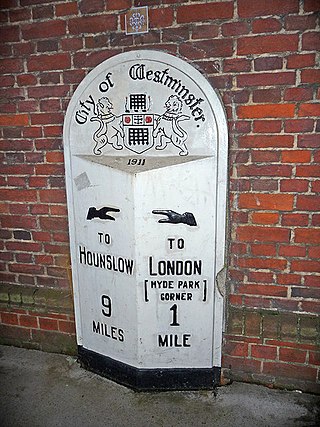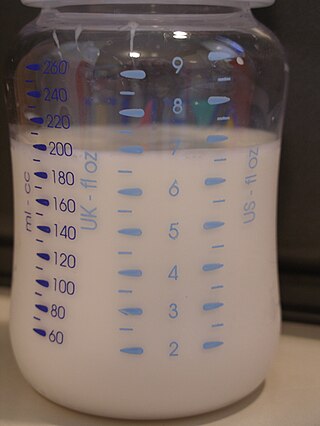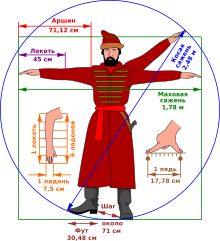
The imperial system of units, imperial system or imperial units is the system of units first defined in the British Weights and Measures Act 1824 and continued to be developed through a series of Weights and Measures Acts and amendments.

The mile, sometimes the international mile or statute mile to distinguish it from other miles, is a British imperial unit and United States customary unit of distance; both are based on the older English unit of length equal to 5,280 English feet, or 1,760 yards. The statute mile was standardised between the Commonwealth of Nations and the United States by an international agreement in 1959, when it was formally redefined with respect to SI units as exactly 1,609.344 metres.

The pound or pound-mass is a unit of mass used in both the British imperial and United States customary systems of measurement. Various definitions have been used; the most common today is the international avoirdupois pound, which is legally defined as exactly 0.45359237 kilograms, and which is divided into 16 avoirdupois ounces. The international standard symbol for the avoirdupois pound is lb; an alternative symbol is lbm, #, and ℔ or ″̶.

United States customary units form a system of measurement units commonly used in the United States and most U.S. territories, since being standardized and adopted in 1832. The United States customary system developed from English units that were in use in the British Empire before the U.S. became an independent country. The United Kingdom's system of measures was overhauled in 1824 to create the imperial system, which was officially adopted in 1826, changing the definitions of some of its units. Consequently, while many U.S. units are essentially similar to their imperial counterparts, there are noticeable differences between the systems.
The ounce is any of several different units of mass, weight, or volume and is derived almost unchanged from the uncia, an Ancient Roman unit of measurement.

The foot is a unit of length in the British imperial and United States customary systems of measurement. The prime symbol, ′, is commonly used to represent the foot. In both customary and imperial units, one foot comprises 12 inches, and one yard comprises three feet. Since an international agreement in 1959, the foot is defined as equal to exactly 0.3048 meters.
The batman was a unit of mass used in the Ottoman Empire and among Turkic peoples of the Russian Empire. It has also been recorded as a unit of area in Uyghur-speaking regions of Central Asia. The name is Turkic, but was also sometimes used for the equivalent unit in Persia. The equivalent unit in British India was anglicized as the maund. The value of the batman varied considerably from place to place.
The dram is a unit of mass in the avoirdupois system, and both a unit of mass and a unit of volume in the apothecaries' system. It was originally both a coin and a weight in ancient Greece. The unit of volume is more correctly called a fluid dram, fluid drachm, fluidram or fluidrachm.

A verst is an obsolete Russian unit of length defined as 500 sazhen. This makes a verst equal to 1.0668 kilometres.

Pood is a unit of mass equal to 40 funt. Since 1899 it is set to approximately 16.38 kilograms. It was used in Russia, Belarus, and Ukraine. Pood was first mentioned in a number of 12th-century documents. Unlike funt, which came at least in the 14th century from Middle High German: phunt, Old East Slavic: пудъ pud is a much older borrowing from Late Latin "pondo", from Classical "pondus".

The apothecaries' system, or apothecaries' weights and measures, is a historical system of mass and volume units that were used by physicians and apothecaries for medical prescriptions and also sometimes by scientists. The English version of the system is closely related to the English troy system of weights, the pound and grain being exactly the same in both. It divides a pound into 12 ounces, an ounce into 8 drachms, and a drachm into 3 scruples of 20 grains each. This exact form of the system was used in the United Kingdom; in some of its former colonies, it survived well into the 20th century. The apothecaries' system of measures is a similar system of volume units based on the fluid ounce. For a long time, medical recipes were written in Latin, often using special symbols to denote weights and measures.
A system of units of measurement, also known as a system of units or system of measurement, is a collection of units of measurement and rules relating them to each other. Systems of measurement have historically been important, regulated and defined for the purposes of science and commerce. Instances in use include the International System of Units or SI, the British imperial system, and the United States customary system.
Traditional Tatar units of measurement were used by Tatars until 1924 but became obsolete when the Soviet Union adopted the metric system.
A zolotnik was a small Russian unit of weight, equal to 0.1505 avoirdupois ounces, or 4.2658 grams. Used from the 10th to 20th centuries, its name is derived from the Russian word zoloto, meaning gold. As a unit, the zolotnik was the standard for silver manufacture, much as the troy ounce is currently used for gold and other precious metals.

Both the British imperial measurement system and United States customary systems of measurement derive from earlier English unit systems used prior to 1824 that were the result of a combination of the local Anglo-Saxon units inherited from Germanic tribes and Roman units.
There are a number of Spanish units of measurement of length or area that are virtually obsolete due to metrication. They include the vara, the cordel, the league and the labor. The units of area used to express the area of land are still encountered in some transactions in land today.
A dessiatin or desyatina is an archaic, rudimentary land measurement used in tsarist Russia. A dessiatin is equal to 2,400 square sazhens and is approximately equivalent to 2.702 English acres or, precisely, 10,925.397 504 square metres.
The international yard and pound are two units of measurement that were the subject of an agreement among representatives of six nations signed on 1 July 1959: Australia, Canada, New Zealand, South Africa, the United Kingdom and the United States. The agreement defined the yard as exactly 0.9144 meters and the avoirdupois pound as exactly 0.45359237 kilograms.

The imperial and US customary measurement systems are both derived from an earlier English system of measurement which in turn can be traced back to Ancient Roman units of measurement, and Carolingian and Saxon units of measure.









